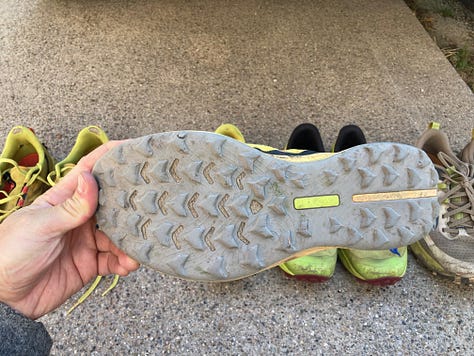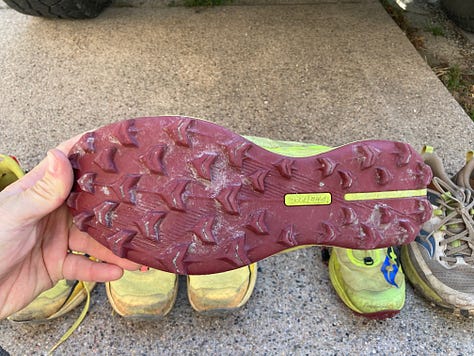
In May of 2022 when I was testing shoes for an iRunFar mud running guide, Saucony sent me a pair of the Peregrine 12 trail running shoes, so I started using them as my primary on-trail running shoe. Then I took them backpacking and I was blown away. They have every single attribute I like a 3-season backpacking shoe to have:
Fairly light. Under 10oz per shoe in a size 10.5
Medium to low drop. I like shoes with 3mm to 7mm drop
Quick drying
Durable, long-lasting outsole
Medium/deep depth lugs: 3mm to 5mm ideally
Medium stack: Averaging around 24.5mm
Firm midsole for support and longevity
Secure heel & midfoot
Wide forefoot
Little to no rocker
Neutral. No stability posts
Rock plate
I’ve come up with this list after trying many shoes, some of which had these attributes and some did not. An incomplete list includes the Altra Lone Peak (versions 4-6), Altra Timp (older), Altra Superior (recent unknown version), Salomon Speedcross 4 & 5, Hoka Torrent, Hoka Challenger ATR 4, Salomon Sense Ride 3, 4 & 5, La Sportiva Mutant, La Sportiva Bushido, Peal iZumi shoes not made anymore, and the Topo MTN Racer 2.
Upon first look, you might notice that almost none of these shoes meet my requirements. Some are soft and flimsy, most don’t have a rock plate, and many are heavily rockered. This is because I’ve only recently figured out what I really want in a shoe. For example, I found the Altras to be comfortable but too sloppy and soft, the Salomons to have either too much drop or too much rocker, and the La Sportivas to have an absolutely bizarre fit. With stability posting, both the Pearl iZumis and Topos sent my knees into misalignment crises.
With this in mind, let’s go through the Peregrine 12 in detail so you can see why I like them so much.
Fit
The Saucony Peregrine 12 has a snug heel and midfoot, keeping my foot locked in place whether I’m side-hilling across slickrock or stepping carefully across an uneven stream bed.
The forefoot, by contrast, is fairly wide. I don’t have a wide forefoot, but because most running shoe lasts are curved and my foot is straight, I need space up there. In most curved-last running shoes I’ll find my pinky toe pressed against the end of the shoe when there is a full inch or more of space in front of my big toe. For whatever reason, this doesn’t happen in the Peregrine 12—all my toes are happy.
Fit is subjective because all feet are different. That said, the Peregrine 12 seems to fit far more feet than I would expect. My partner Hallie has an exceptionally wide forefoot and a narrow heel and loves the Peregrine 12. It is, in her words, the only shoe she’s ever worn that hasn’t killed her feet while backpacking.
Drop & Stack
The Peregrine 12 has a stack height of 26.5mm in the heel and 22.5mm in the forefoot. The drop is 4mm. This is pretty ideal for a backpacking shoe. A higher overall stack (think Speedgoat) could be more prone to tipiness. A higher heel and 10mm drop (think Speedross) is highly prone to tipping, especially when your heel lands directly on an obstacle. A higher drop can also drive the ball of the foot into the front of the shoe, straining the plantar tendon, in my experience.
Lowering the center of gravity and minimizing the difference between heel and toe is a great recipe for a stable shoe. That said, zero drop doesn’t work for me—I want just a little calf relief. If the Peregrine 12 had 6mm of drop, I’d likely still be very happy with them.
Outsole
The outsole compound grips well to most surfaces, including wet rock. It’s not as good as some sticky rubber compounds I’ve encountered, but it’s far better than, say Altra outsoles. At 5mm, the lugs are deep but not too deep and widely spaced but not too widely spaced. I find that traction on firmer surfaces plummets when the lugs are too big or too widely spaced. Those types of shoes excel in mud. My first pair of Peregrine 12s are a year and a half old at this point and there is still a decent amount of traction left. They have lasted far longer than most shoes I’ve used for a combination of running, hiking, and backpacking. I don’t know what is special about this tread but it’s great.
Upper
I don’t think too much about a shoe’s upper because it usually wears out at the same time as other, more critical parts of the shoe. This seems to be the case with the Peregrine 12. I’m wearing through in places (see pics), but this wear is happening in tandem with the outsole wear. I do wish that the mesh was more tightly woven. This is my singular criticism of this shoe—sand gets in.
Midsole
The main thing (aside from the fit) that sets this shoe above any other shoes I’ve tried is the firm yet light and comfortable PWRRUN midsole. At a year and a half of use, I don’t find my first pair of Peregrine 12s to be notably packed out. Usually, when a shoe packs out I start noticing the ground under my feet and my knees start feeling misaligned due to compressed EVA foam. Not the case with this shoe. Altra Lone Peaks pack out in about 3 months, in comparison. The takeaway? You can backpack for hundreds of miles with this shoe and it doesn’t really ever feel markedly different. Which is pretty amazing.
I’ve been using the latest iteration, the Peregrine 13, for running but not backpacking. It features a softer EVA compound in the midsole which is super comfortable but saps energy, in my opinion. I also don’t expect it to last nearly as long as the old compound. If it packs out more quickly, my joints could start to feel it in sooner than a year. Hard to say, though. I’ll just have to keep testing the 13 and report back.
Conclusion
The Saucony Peregrine 12 is a light, durable trail running shoe with a snug but accommodating fit, medium/low drop, and the perfect firm midsole for backpacking. My first pair of these shoes have lasted nearly a year and a half and are still going strong. I can’t say the same thing about any other shoe trail running shoe I’ve used for backpacking. Nothing lasts like this. I must note I did not use them exclusively during this time, but they were my primary shoe.
The midsole is the standout feature—it’s firm while still being comfortable. The firmness seems to translate to durability because my 16-month-old shoes don’t feel much different than they did when they were new. A shoe that doesn’t seem to really change all that much in that time span is something worth writing about.












